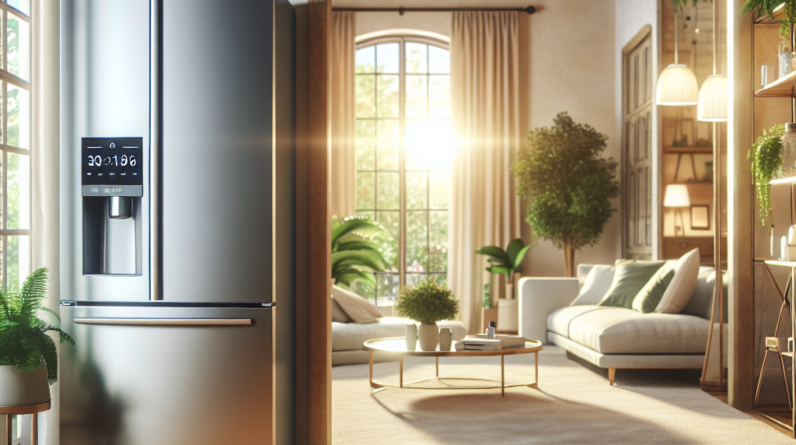
Are you looking for energy-efficient options to upgrade your window treatments while also being mindful of sustainability? Look no further! In this article, we will explore some fantastic choices that not only enhance the aesthetic appeal of your windows but also contribute to a greener environment. By making small changes to your window treatments, you can conserve energy, reduce greenhouse gas emissions, and lower your energy bills. So, let’s delve into the world of sustainable window treatments and discover the perfect option for you.

Shop Sustainable Appliances on Amazon Here
Insulating Window Treatments
When it comes to energy-efficient window treatments, insulating options are a great choice. Insulating window treatments help to prevent heat transfer, keeping your home warm in the winter and cool in the summer. One popular option for insulating window treatments is cellular shades. These shades are designed with honeycomb-shaped cells that trap air, creating a layer of insulation between your window and the room. They are available in various styles and colors to complement any decor.
Another option for insulating window treatments is curtains and drapes. Thick, heavy curtains made from insulating fabrics can help to block drafts and reduce heat loss through the windows. In the winter, you can close the curtains at night to keep the warmth in, and in the summer, you can close them during the day to keep the heat out. They also provide additional benefits such as blocking light and ensuring privacy.
Window films are also a popular choice for insulating window treatments. These films are applied directly to the window glass and help to reduce heat transfer by reflecting sunlight and blocking harmful UV rays. They are available in different levels of insulation and can be easily installed on any window. Window films are a cost-effective option for improving the energy efficiency of your windows.
Reflective Window Treatments
Reflective window treatments are another energy-efficient option that can help to reduce heat gain and improve the comfort of your home. Window blinds, such as venetian blinds or roller blinds, are a popular choice for reflective window treatments. These blinds have adjustable slats or panels that can be tilted to reflect sunlight and block heat from entering the room. By blocking out the sun’s rays, reflective blinds can help to keep your home cooler in the summer and reduce the need for air conditioning.
Solar shades are also a great choice for reflective window treatments. These shades are made from a special fabric that is designed to block UV rays and reduce glare while still allowing natural light to filter into the room. Solar shades can be installed on windows and are particularly useful in rooms that receive direct sunlight. They not only help to keep the room cooler but also protect your furniture and belongings from fading due to sun exposure.
Smart Window Treatments
If you’re looking for a high-tech and convenient option for energy-efficient window treatments, smart window treatments are the way to go. Motorized shades are a popular choice in smart window treatments. These shades can be controlled remotely through a smartphone app or a smart home system, allowing you to easily adjust the amount of light and privacy in your home. Motorized shades can be programmed to open and close at specific times, maximizing energy efficiency and allowing natural light to enter the room when desired.
Automated blinds are another option in smart window treatments. These blinds are equipped with sensors that can detect changes in sunlight and temperature, automatically adjusting the blinds to optimize energy efficiency. For example, if the room becomes too warm, the blinds can lower to block out the sunlight and reduce heat gain. Automated blinds provide a hands-free solution for energy-efficient window treatments.

Shop Sustainable Appliances on Amazon Here
Multi-Pane Windows
When it comes to improving the energy efficiency of your windows, multi-pane windows are a popular choice. Double pane windows consist of two layers of glass separated by an insulating gas, such as argon or krypton. This construction helps to reduce heat transfer and improve thermal insulation. The insulating gas acts as a barrier, minimizing heat loss in the winter and heat gain in the summer. Triple pane windows, on the other hand, consist of three layers of glass and provide even better insulation and energy efficiency.
Multi-pane windows are an excellent investment for homeowners looking to reduce their energy consumption and lower their heating and cooling costs. They provide better insulation than single pane windows and help to maintain a consistent and comfortable temperature inside your home. Additionally, multi-pane windows also offer improved soundproofing, reducing external noise and creating a quieter living environment.
Window Sealing Options
To further enhance the energy efficiency of your windows, window sealing options can help to eliminate drafts and air leakage. Caulking is a common method used to seal gaps and cracks around windows. It is applied to the joints and seams between the window frame and the wall, creating a tight seal to prevent air infiltration. Caulking is an inexpensive and relatively easy DIY solution that can significantly improve the energy efficiency of your windows.
Weatherstripping is another effective option for sealing windows. It involves applying a strip of material, such as foam or rubber, to the moving parts of the window, such as the sash or frame. Weatherstripping creates a barrier against drafts and helps to maintain a comfortable indoor environment. It is available in different materials and forms, allowing you to choose the most appropriate option for your windows.
Energy-efficient Window Frame Materials
When considering energy-efficient window treatments, it’s essential not to overlook the importance of window frame materials. The material of your window frames can have a significant impact on the overall energy efficiency of your windows. Vinyl frames are a popular choice when it comes to energy efficiency. They are highly insulating and do not conduct heat or cold well, helping to minimize heat transfer and improve thermal performance. Vinyl frames also require minimal maintenance and are resistant to decay, rust, and fading.
Fiberglass frames are another excellent option for energy-efficient window frame materials. They are extremely durable and provide excellent insulation properties. Fiberglass frames expand and contract at the same rate as the glass, reducing the risk of seal failure and air leakage. Additionally, fiberglass frames are environmentally friendly and can be recycled at the end of their lifespan.
Wood frames are a classic and aesthetically pleasing choice for window frames. They have natural insulating properties and can provide excellent energy efficiency when properly sealed and maintained. Wood frames offer excellent thermal performance and can help to reduce heat transfer. However, they do require regular maintenance to prevent rot and decay.
Tinted Window Treatments
Tinted window treatments are a practical and stylish way to improve the energy efficiency of your windows. Tinted glass is a popular option for tinted window treatments. It is manufactured by adding a thin layer of tinting film to the glass during the manufacturing process. Tinted glass helps to reduce glare, block UV rays, and minimize heat transfer. It can significantly reduce the amount of solar heat gain in your home, keeping it cooler and more comfortable in the summer.
Window tint films are another option for tinted window treatments. These films are applied directly to the window glass and provide similar benefits to tinted glass. Window tint films are available in various shades and levels of tint, allowing you to customize the amount of light and heat you want to block. They can be easily installed on any window and offer a cost-effective solution for improving the energy efficiency of your windows.
Exterior Window Treatments
Exterior window treatments can have a significant impact on the energy efficiency of your home. Awnings are a popular choice for exterior window treatments. They are installed above windows and provide shade and protection from the sun. By blocking direct sunlight, awnings can significantly reduce heat gain and keep your home cooler. Additionally, awnings can also help to protect your windows from adverse weather conditions, prolonging their lifespan.
Shutters are another option for exterior window treatments. They are installed on the outside of windows and offer excellent insulation and energy efficiency. Shutters can be closed during the winter to provide an extra layer of insulation and keep the heat in. In the summer, they can be opened to allow natural light and ventilation while still providing shade and reducing heat gain.
Exterior shades, also known as sun shades, are a popular choice for energy-efficient exterior window treatments. These shades are installed on the outside of windows and can be lowered or raised to control the amount of sunlight and heat entering your home. Exterior shades are designed to reflect sunlight and block UV rays, helping to keep the interior cool and comfortable.
Energy-efficient Blinds
Blinds are a versatile window treatment option that can provide both style and energy efficiency. Top-down/bottom-up blinds are a popular choice for energy-efficient blinds. These blinds can be adjusted from both the top and the bottom, allowing you to control the amount of light and privacy while still maintaining ventilation. By lowering the top and raising the bottom, you can let in natural light while maintaining privacy. Top-down/bottom-up blinds help to maximize energy efficiency by minimizing the need for artificial lighting during the day.
Insulating blinds are another excellent choice for energy-efficient window treatments. These blinds are typically made from thicker materials and have added insulating properties. Insulating blinds create a barrier between the window and the room, reducing heat transfer and improving thermal insulation. They are particularly effective in preventing drafts and reducing the need for heating or cooling.
Window Covering Design Tips
To make the most of your energy-efficient window treatments, consider these design tips for window coverings. Layered window treatments can provide both energy efficiency and style. Combining different types of window treatments, such as curtains and blinds, can help to improve insulation and block out unwanted light. Layered window treatments also create a visually appealing look by adding depth and texture to your windows.
Using light-colored fabrics for your window treatments can also help to enhance energy efficiency. Lighter colors reflect sunlight and heat, preventing heat gain and keeping your home cooler. Opting for lighter shades of curtains, drapes, or blinds can make a significant difference in the room’s temperature and energy consumption.
Vertical blinds are an excellent choice for sliding doors and large windows. Their vertical orientation allows for easy adjustment and control of light and privacy. Vertical blinds can be tilted to let in natural light while still maintaining privacy, making them an energy-efficient option for sliding doors.
In conclusion, there are several energy-efficient options for sustainable window treatments. Insulating window treatments such as cellular shades, curtains, and drapes, and window films help to prevent heat transfer and improve thermal insulation. Reflective window treatments like blinds and solar shades can reduce heat gain and block out harmful UV rays. Smart window treatments such as motorized shades and automated blinds offer convenience and energy efficiency. Multi-pane windows, window sealing options, and energy-efficient window frame materials can significantly improve insulation and reduce energy consumption. Tinted window treatments provide added protection from the sun’s rays. Exterior window treatments like awnings, shutters, and exterior shades offer further energy savings. Energy-efficient blinds, including top-down/bottom-up blinds and insulating blinds, provide both style and energy efficiency. By considering these options and design tips, you can create a more sustainable and energy-efficient home.





